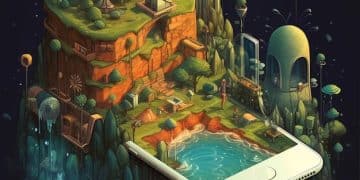Unlock Procedural Generation in Unreal Engine 5 by Jan 2025

Mastering procedural generation in Unreal Engine 5 empowers developers to create vast, unique, and dynamic game worlds efficiently, saving significant development time and fostering unprecedented player immersion through endless exploration possibilities, with advanced tools and techniques poised for widespread integration by January 2025.
The promise of infinitely varied landscapes, bustling cities, and dynamic content has long captivated game developers. With Unreal Engine 5’s procedural generation capabilities, that promise is now more tangible than ever. This guide explores the essential techniques and considerations for leveraging these powerful tools to craft unique game worlds by January 2025.
The Power of Procedural Generation in Game Development
Procedural generation, fundamental to modern game design, refers to the algorithmic creation of data rather than manual asset placement. This methodology dramatically scales content creation, enabling developers to build expansive and diverse game worlds that would otherwise be impossible to craft by hand.
Consider the logistical challenges of designing every rock, tree, or building in a massive open-world game. Manual placement is time-consuming, resource-intensive, and prone to repetition. Procedural approaches offer a compelling alternative, allowing for vast landscapes, intricate dungeons, or varied enemy types to emerge from a set of rules and parameters.
Enhanced Scalability and Efficiency
One of the primary benefits of procedural generation lies in its profound impact on development scalability. Instead of designing individual assets, developers define systems that generate them. This paradigm shift means that as the complexity or size of a game world increases, the work required does not scale linearly; rather, it grows logarithmically.
- Reduces manual asset creation time significantly.
- Enables the creation of much larger and more complex worlds.
- Frees up artists and designers to focus on unique, hand-crafted elements.
This efficiency gain is critical for indie studios with limited resources, allowing them to compete with larger developers in terms of content volume. It also benefits large teams by streamlining repetitive tasks and accelerating prototyping phases.
Infinite Exploration and Replayability
Beyond efficiency, procedural generation profoundly impacts player experience. Games can offer novel experiences with each playthrough, as environments, quests, or challenges are dynamically generated. This unpredictability fosters a sense of discovery and encourages extensive exploration, boosting replayability and player retention.
For games focused on exploration, survival, or roguelikes, procedural generation is not just a feature but a core mechanic. It ensures that every session feels fresh, preventing stagnation and extending the perceived content lifespan of the game. Players are constantly discovering new vistas and encountering unexpected scenarios.
Ultimately, procedural generation transforms the development pipeline from a labor-intensive, asset-driven process into a systematic, rule-based approach. This allows for unparalleled scope and variety, fulfilling the ambition of creating truly unique and dynamic game worlds in Unreal Engine 5.
Core Concepts and Techniques in Unreal Engine 5
Unreal Engine 5 offers a robust suite of tools and systems tailored for advanced procedural generation. Understanding these core concepts is crucial for any developer aiming to craft dynamic and engaging virtual environments. The engine’s blueprint system, coupled with its advanced rendering capabilities, provides a powerful foundation.
Blueprint-Driven Generation and Runtime Complexity
The Blueprint visual scripting system is a cornerstone of Unreal Engine 5’s procedural capabilities. Developers can create complex generation logic using drag-and-drop nodes, without writing a single line of C++ code. This accessibility lowers the barrier to entry, allowing designers and artists to contribute directly to generation systems.
Blueprint allows for both static generation (pre-calculating the world before runtime) and runtime generation (creating content as the player explores). Runtime generation, while more computationally intensive, offers unparalleled dynamic possibilities, such as evolving landscapes or destructible environments that change based on player actions.
- Utilize Blueprint nodes for geometric placement and attribute manipulation.
- Leverage construction scripts for quick iteration and visualization during development.
- Implement data tables and curves to control generation parameters dynamically.
Managing the performance impact of runtime generation is critical. Techniques like object pooling, level streaming, and optimized LOD (Level of Detail) systems become essential to maintain smooth frame rates even in incredibly dense and dynamic worlds.
Noise Functions and Perlin Algorithms

At the heart of many procedural generation algorithms lie noise functions, with Perlin noise being a prominent example. These mathematical functions generate seemingly random, yet consistently coherent, values across a grid. This coherence is what allows for the creation of natural-looking terrains, realistic textures, and organic distribution patterns.
Perlin noise, Simplex noise, and Worley noise each offer distinct visual characteristics. By combining and manipulating these noise functions, developers can sculpt diverse geographical features, from rolling hills and jagged mountains to intricate cave systems and chaotic asteroid fields. The parameters of noise functions—frequency, amplitude, and octaves—allow for fine-grained control over the generated morphology.
The application of noise functions extends beyond terrain. They can drive the placement of foliage, the distribution of resources, the variation in enemy patrols, or even the subtle imperfections on a building’s surface, contributing to realism and visual variety.
Advanced Generation Systems: PCG Framework (Experimental)
Unreal Engine 5 introduces the Procedural Content Generation (PCG) Framework, an experimental but incredibly powerful system designed to streamline procedural workflows. PCG allows developers to define complex generation graphs that process input data (like a landscape or spline) and output generated content (like foliage, rocks, or buildings).
The PCG framework operates non-destructively, meaning changes can be made to parameters without destroying previously generated data. This iterative workflow is invaluable for experimenting and refining generation rules. It supports a wide array of nodes, from simple transforms to complex pattern recognition and density scattering algorithms.
While still experimental, the PCG Framework holds immense promise for consolidating and simplifying procedural pipelines within Unreal Engine 5, offering a unified approach to content distribution and world population. Its integration will likely become central to efficient large-scale world building by January 2025.
Building Unique Game Worlds: Step-by-Step Approach
Crafting a unique game world through procedural generation is an iterative process that blends algorithmic design with artistic direction. This step-by-step guide outlines a practical approach within Unreal Engine 5, moving from foundational landscape generation to detailed environment population.
Generating the Foundation: Landscape and Biome Placement
The first step in building any unique world is establishing its geological foundation. This typically involves using noise functions to generate a base landscape. Unreal Engine’s landscape system can be driven by heightmaps derived from Perlin or Simplex noise, scaled and offset to create primary terrain features like mountains, valleys, and plateaus.
Once the basic topography is established, biomes can be procedurally defined. This involves using additional noise maps, or even real-world geographical data, to define areas for deserts, forests, tundras, or oceans. These biome maps then dictate the assets and environmental rules for specific regions, ensuring logical and visually distinct areas within the larger world.
Populating with Dynamic Flora and Fauna
With the landscape and biomes in place, the next layer of detail involves populating the world with flora (vegetation) and fauna (wildlife). Using the PCG Framework or custom Blueprint systems, developers can scatter trees, bushes, and grass based on density maps, terrain slope, and biome type.
For wildlife, procedural systems can define patrol paths, spawning zones, and AI behaviors that adapt to the environment. For example, a predator might only spawn in denser forest areas, while a grazer prefers open plains. This dynamic population adds organic movement and life to the world, making it feel inhabited and alive.
- Utilize Unreal Engine’s Foliage system for optimized vegetation rendering.
- Implement Blueprint interfaces for AI behaviors that interact with procedurally generated terrain.
- Leverage distance-based culling for both flora and fauna to maintain performance in large worlds.
The goal is to create a believable ecosystem where elements interact naturally, rather than appearing as static, disconnected assets. This level of simulated complexity enhances player immersion and world credibility.
Structuring Points of Interest and Narrative Elements
While random generation creates vastness, carefully placed points of interest (POIs) provide structure and guide player progression. These can include ancient ruins, abandoned settlements, or critical quest locations. Procedural generation can aid in their placement and internal layout, but often a degree of hand-crafting or templating is required to ensure narrative significance.
For example, a procedural dungeon generator might use a set of hand-designed room templates stitched together algorithmically. This hybrid approach combines the efficiency of procedural generation with the intentionality of curated content. Narrative elements, too, can emerge from procedural systems, such as dynamically generated character backstories or branching dialogue options driven by player choices within a procedurally generated world.
The challenge lies in balancing the emergent nature of procedural generation with the need for a cohesive and engaging player experience. By strategically integrating hand-crafted elements, developers can ensure that the “unique” aspects of the world contribute positively to the overall game narrative and playability.
Tools and Best Practices for Implementation
Implementing effective procedural generation in Unreal Engine 5 requires not only a grasp of core concepts but also an understanding of the specific tools available and the best practices for leveraging them. Optimization and thoughtful design are paramount to creating high-performance, dynamic worlds.
Working with the PCG Framework (Experimental but Powerful)
As mentioned, Unreal Engine 5’s PCG Framework is poised to become a central tool for procedural content. While currently experimental, it offers a visual node-based system for building complex generation graphs. Developers should familiarize themselves with its capabilities, including:
- Point Generation: Creating points across a landscape, spline, or volume.
- Attribute Manipulation: Modifying point data (scale, rotation, density) based on input.
- Sampling and Scattering: Distributing assets or other PCG graphs based on these points.
- Debugging Tools: Visualizing generated data in real-time within the editor.
The PCG Framework allows for incredibly dense and varied distributions of assets directly within the engine, significantly accelerating the workflow for populating large environments. Its non-destructive nature encourages experimentation and iterative design, which is crucial for procedural systems.
Optimization Techniques for Large Procedural Worlds
Procedurally generated worlds, by their nature, can be incredibly resource-intensive. Effective optimization is not an afterthought but an integral part of the design process. Key techniques include:
Level Streaming and World Partition
Unreal Engine 5’s World Partition system is a game-changer for large open worlds. It automatically streams in and out relevant portions of the world based on the player’s proximity, rather than loading the entire map at once. This significantly reduces memory footprint and improves loading times.
Coupled with Level Streaming, which allows developers to manually load and unload specific world segments, these systems are critical for managing the vastness of procedurally generated content. Ensuring that procedural generation scripts are compatible with these streaming mechanisms is vital for performance.
LODs, HLODs, and Instancing
Level of Detail (LOD) allows for simpler versions of models to be rendered further away from the camera, reducing polygon count. Hierarchical LODs (HLODs) go a step further, combining multiple distant meshes into single, optimized proxy meshes.
Instancing, particularly with the Hierarchical Instanced Static Mesh (HISM) component, is essential for rendering thousands or millions of identical objects (like trees or rocks) with minimal draw calls. Procedural generation systems should leverage HISM extensively to avoid performance bottlenecks when populating dense environments.
Debugging and Iteration Strategies
Debugging procedural systems can be complex due to the emergent nature of the output. Visual debugging tools within Unreal Engine, such as the PCG visualizer or custom Blueprint debug drawing, are indispensable for understanding why content is generating (or failing to generate) in a particular way.
An iterative approach is crucial. Start with simple generation rules, verify their output, and gradually add complexity. Version control (e.g., Plastic SCM or Git) is also critical, allowing developers to revert to previous stable states if a new rule introduces unwanted artifacts or crashes.
Testing generated worlds with various parameters and across different hardware configurations ensures robustness and consistent performance. Automation, where possible, for testing generated scenarios can further accelerate the iteration cycle, enabling rapid refinement of world generation algorithms.
Challenges and Considerations for Future Development
While procedural generation offers immense promise, developers face several challenges that require careful consideration. As the field evolves, addressing these issues will be key to unlocking its full potential and truly realizing compelling, dynamic worlds by January 2025.
Ensuring Quality and Art Direction Consistency
A common pitfall of purely random procedural generation is a lack of artistic consistency or a “sameness” that permeates the world despite variation. It can be challenging to maintain a specific art style or thematic coherence when content is algorithmically generated.
The solution often lies in a hybrid approach: defining strong artistic guidelines and templates for the procedural systems to adhere to. This might involve:
- Curating diverse asset packs that fit the art style.
- Using carefully crafted rules to prevent “impossible” or jarring combinations.
- Implementing quality assurance passes that identify and allow manual refinement of problematic areas.
The goal is to ensure that while the world is unique, it still feels intentionally designed and aesthetically pleasing, reinforcing the game’s overall vision rather than undermining it with visual noise.
Managing Performance and Scale in Real-time
As previously mentioned, the computational demands of procedural generation, especially at runtime, can be enormous. Generating vast, detailed worlds while maintaining high frame rates is a constant struggle. Future development must focus on more efficient algorithms, better hardware utilization, and advanced culling techniques. Technologies like Nanite and Lumen in Unreal Engine 5 already contribute significantly by handling vast geometric detail and global illumination with impressive performance.
However, the challenge remains for generative processes themselves. Developers will increasingly need to leverage multi-threading, GPU-based computation (with tools like Unreal’s Niagara fluid simulation or custom compute shaders), and sophisticated streaming mechanisms to meet the growing demand for dynamic content in highly detailed environments.
The Human Element: Avoiding Monotony and Adding Narrative Depth
Even with boundless variety, procedurally generated worlds can sometimes feel soulless or lack the narrative weight found in hand-crafted experiences. True immersion often comes from deliberate design choices, impactful events, and a sense of history within the environment.
Integrating narrative generation systems, dynamic quest creation, and AI that responds intelligently to the generated world will be crucial. This involves not just placing objects but also defining relationships between them, creating emergent stories, and ensuring that player actions have meaningful, persistent impacts on the dynamically evolving world.
The human element in procedural generation lies not in its ability to eliminate manual work entirely, but in its capacity to amplify the impact of careful design, allowing developers to focus on crafting core experiences while the engine handles the breadth and scale of content. By January 2025, these advanced techniques will likely be more integrated, enabling even more sophisticated and seamless world creation.
The Future of Procedural Generation in Unreal Engine 5
The trajectory of procedural generation within Unreal Engine 5 is one of increasing sophistication, integration, and accessibility. As the engine matures and hardware capabilities advance, the opportunities for designers and developers to create truly dynamic and responsive worlds will expand exponentially. The timeframe leading up to January 2025 is critical for this evolution.
Beyond Landscape: Cities, Dungeons, and Narrative Generation
While terrain generation has been a long-standing application, the future sees procedural techniques extending much further. We can anticipate:
- Advanced City Generators: Systems that dynamically create urban environments, complete with buildings, road networks, and intricate urban planning logic, adapting to terrain and simulated socio-economic factors.
- Modular Dungeon and Interior Generation: Algorithms capable of seamlessly generating complex multi-level dungeons, interior spaces, and even complete architectural structures, maintaining thematic consistency and gameplay flow.
- Narrative and Quest Generation: The most ambitious frontier, where systems don’t just create environments but also characters, storylines, and quests that dynamically emerge from the generated world, offering unparalleled replayability through emergent storytelling.
These advanced applications will move beyond simple asset scattering to truly systemic creation, where the relationships between elements are as important as the elements themselves, fostering a more cohesive and believable world.
AI-Driven Procedural Generation and Machine Learning
Machine learning and artificial intelligence are poised to revolutionize procedural generation. Imagine an AI that learns desired artistic styles from examples and then generates new content adhering to those aesthetics. Or an AI that analyzes player behavior and dynamically adjusts the world to offer personalized challenges or experiences.
AI could optimize generation parameters on the fly, predict potential performance bottlenecks, or even assist in the debugging process by identifying illogical or repetitive patterns. This integration promises a leap from rule-based systems to intelligent, adaptive generation that is more responsive and nuanced. By 2025, experimental AI modules for generating game content will likely be a more commonplace feature in engines like Unreal.
Accessibility and Community Contribution
As procedural tools become more powerful, there will be a continued push for greater accessibility. The PCG Framework, once fully integrated and stable, will serve as a powerful example of this. More intuitive interfaces, better documentation, and a thriving community sharing blueprints and custom nodes will empower a new generation of creators to harness these complex features without needing deep programming knowledge.
This democratization of advanced P.G. techniques will lead to an explosion of creativity, with smaller teams and even individual developers capable of building game worlds that rival those of much larger studios in terms of scale and uniqueness. The barrier to entry for creating truly massive and dynamic games will continue to lower, fostering greater innovation across the industry.
The journey to mastering procedural generation in Unreal Engine 5 by January 2025 is about embracing these cutting-edge techniques and anticipating the next wave of innovation. It’s about empowering developers to build not just worlds, but entire universes, each with its own story and unique character, ready for players to explore.
| Key Aspect | Brief Description |
|---|---|
| 💡 Core Benefits | Scales content creation, enables vast unique worlds, boosts replayability. |
| 🛠️ UE5 Tools | Blueprints, Noise functions, experimental PCG Framework for robust generation. |
| ⚖️ Optimizations | World Partition, LODs, HLODs, and Instancing are crucial for performance. |
| 🔮 Future Outlook | AI integration, advanced urban/narrative generation, increased accessibility. |
Frequently Asked Questions about Procedural Generation in Unreal Engine 5
▼
Procedural generation in Unreal Engine 5 involves using algorithms to create game content like landscapes, assets, or narratives, rather than manual placement. It’s crucial for efficiently building vast, unique, and highly replayable game worlds that would otherwise be impractical or impossible to design by hand, saving development time and resources.
▼
Unreal Engine 5 offers several powerful tools for procedural generation. Key among them are the Blueprint visual scripting system for logical design, various noise functions (like Perlin and Simplex) for organic forms, and the experimental Procedural Content Generation (PCG) Framework, which is specifically designed for complex, non-destructive content distribution.
▼
Optimizing performance in large procedurally generated worlds requires strategic use of Unreal Engine’s features. Essential techniques include leveraging World Partition and Level Streaming for efficient data management, using Levels of Detail (LODs) and Hierarchical LODs (HLODs) for distant geometry, and instancing static meshes to reduce draw calls when populating environments with many similar objects.
▼
Beyond performance, significant challenges include maintaining artistic consistency and thematic coherence across algorithmically generated content. It’s also vital to avoid monotony, ensuring that despite the procedural variation, the world retains unique points of interest and integrates seamlessly with narrative elements to provide a compelling and engaging player experience.
▼
The future of procedural generation in Unreal Engine 5 is bright, with anticipated advancements in AI-driven generation, increased sophistication in creating complex cities and narrative structures, and greater accessibility for developers. These improvements will allow for more dynamic, adaptive, and personalized game worlds, pushing the boundaries of what is possible in game design.
Conclusion
The journey towards mastering procedural generation in Unreal Engine 5 is one of immense potential, offering developers the unparalleled ability to create expansive, dynamic, and truly unique game worlds. By embracing the engine’s powerful tools, understanding core concepts, and adhering to best practices, studios of all sizes can efficiently craft immersive experiences that captivate players with endless exploration and novel content. As we approach January 2025, continued innovation and refinement in this field promise to reshape game development, making the creation of rich, vibrant, and infinitely varied virtual realities more accessible and impactful than ever before.





